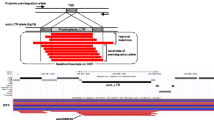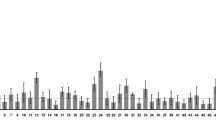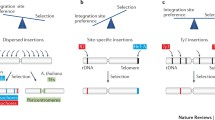Abstract
Retroelements (REs) occupy up to 40% of the human genome. Newly integrated REs can change the pattern of expression of pre-existing host genes and therefore might play a significant role in evolution. In particular, human- and primate-specific REs could affect the divergence of the Hominoidea superfamily. A comparative genome-wide analysis of RE sites of integration, neighboring genes, and their regulatory interplay in human and ape genomes would be of help in understanding the impact of REs on evolution and genome regulation. We have developed a technique for the genome-wide comparison of the integrations of transposable elements in genomic DNAs of closely related species. The technique called targeted genome differences analysis (TGDA) is also useful for the detection of deletion/insertion polymorphisms of REs. The technique is based on an enhanced version of subtractive hybridization and does not require preliminary knowledge of the genome sequences under comparison. In this report, we describe its application to the detection and analysis of human specific L1 integrations and their polymorphisms. We obtained a library highly enriched in human-specific L1 insertions and identified 24 such new insertions. Many of these insertions are polymorphic in human populations. The total number of human-specific L1 inserts was estimated to be ~4000. The results suggest that TGDA is a universal method that can be successfully used for the detection of evolutionary and polymorphic markers in any closely related genomes.

Similar content being viewed by others
References
Boissinot S, Chevret P, Furano AV (2000) L1 (LINE-1) retrotransposon evolution and amplification in recent human history. Mol Biol Evol 17:915–928
Brooks EM, Branda RF, Nicklas JA, O'Neill JP (2001) Molecular description of three macro-deletions and an Alu-Alu recombination-mediated duplication in the HPRT gene in four patients with Lesch-Nyhan disease. Mutat Res 476:43–54
Buzdin A, Khodosevich K, Mamedov I, Vinogradova T, Lebedev Y, Hunsmann G, Sverdlov E (2002a) A technique for genome-wide identification of differences in the interspersed repeats integrations between closely related genomes and its application to detection of human-specific integrations of HERV-K LTRs. Genomics 79:413–422
Buzdin A, Ustyugova S, Gogvadze E, Vinogradova T, Lebedev Y, Sverdlov E (2002b) A new family of chimeric retrotranscripts formed by a full copy of u6 small nuclear RNA fused to the 3' terminus of L1. Genomics 80:402–406
Carroll ML, Roy-Engel AM, Nguyen SV, Salem AH, Vogel E, Vincent B, Myers J, Ahmad Z, Nguyen L, Sammarco M, Watkins WS, Henke J, Makalowski W, Jorde LB, Deininger PL, Batzer MA (2001) Large-scale analysis of the Alu Ya5 and Yb8 subfamilies and their contribution to human genomic diversity. J Mol Biol 311:17–40
Deininger PL, Batzer MA (1999) Alu repeats and human disease. Mol Genet Metab 67:183–193
Goodier JL, Ostertag EM, Kazazian HH Jr (2000) Transduction of 3'-flanking sequences is common in L1 retrotransposition. Hum Mol Genet 9:653–657
International Human Genome Sequencing Consortium (2001) Initial sequencing and analysis of the human genome. Nature 409:860–921
Kazazian HH Jr (2000) Genetics. L1 retrotransposons shape the mammalian genome. Science 289:1152–1153
Kazazian HH Jr, Moran JV (1998) The impact of L1 retrotransposons on the human genome. Nat Genet 19:19–24
Lavrentieva I, Broude NE, Lebedev Y, Gottesman II, Lukyanov SA, Smith Cl, Sverdlov ED (1999) High polymorphism level of genomic sequences flanking insertion sites of human endogenous retroviral long terminal repeats. FEBS Lett 443:341–347
Lebedev Y, Belonovich O, Zybrova N, Khil P, Kurdyukov S, Vinogradova T, Hunsmann G, Sverdlov E (2000) Differences in HERV-K LTR insertions in orthologous loci of human and great apes. Gene 247:265–277
Lower R (1999) The pathogenic potential of endogenous retroviruses: facts and fantasies. Trends Microbiol 7:350–356
Medstrand P, Mager DL (1998) Human-specific integrations of the HERV-K endogenous retrovirus family. J Virol 72:9782–9787
Meischl C, Boer M, Ahlin A, Roos D (2000) A new exon created by intronic insertion of a rearranged LINE-1 element as the cause of chronic granulomatous disease. Eur J Hum Genet 8:697–703
Moran JV (1999) Human L1 retrotransposition: insights and peculiarities learned from a cultured cell retrotransposition assay. Genetica 107:39–51
Moran JV, DeBerardinis RJ, Kazazian HH Jr (1999) Exon shuffling by L1 retrotransposition. Science 283:1530–1534
Myers JS, Vincent BJ, Udall H, Watkins WS, Morrish TA, Kilroy GE, Swergold GD, Henke J, Henke L, Moran JV, Jorde LB, Batzer MA (2002) A comprehensive analysis of recently integrated human Ta L1 elements. Am J Hum Genet 71:312–326
Ostertag EM, Kazazian HH Jr (2001) Twin priming: a proposed mechanism for the creation of inversions in L1 retrotransposition. Genome Res 11:2059–2065
Ovchinnikov I, Troxel AB, Swergold GD (2001) Genomic characterization of recent human LINE-1 insertions: evidence supporting random insertion. Genome Res 11:2050–2058
Pickeral OK, Makalowski W, Boguski MS, Boeke JD (2000) Frequent human genomic DNA transduction driven by LINE-1 retrotransposition. Genome Res 10:411–415
Saikawa Y, Kaneda H, Yue L, Shimura S, Toma T, Kasahara Y, Yachie A, Koizumi S (2000) Structural evidence of genomic exon-deletion mediated by Alu-Alu recombination in a human case with heme oxygenase-1 deficiency. Hum Mutat 16:178–179
Schwahn U, Lenzner S, Dong J, Feil S, Hinzmann B, Duijnhoven G van, Kirschner R, Hemberger M, Bergen AA, Rosenberg T, Pinckers AJ, Fundele R, Rosenthal A, Cremers FP, Ropers HH, Berger W (1998) Positional cloning of the gene for X-linked retinitis pigmentosa 2. Nat Genet 19:327–332
Sheen FM, Sherry ST, Risch GM, Robichaux M, Nasidze I, Stoneking M, Batzer MA, Swergold GD (2000) Reading between the LINEs: human genomic variation induced by LINE-1 retrotransposition. Genome Res 10:1496–1508
Smit AF, Toth G, Riggs AD, Jurka J (1995) Ancestral, mammalian-wide subfamilies of LINE-1 repetitive sequences. J Mol Biol 246:401–417
Turner G, Barbulescu M, Su M, Jensen-Seaman MI, Kidd KK, Lenz J (2001) Insertional polymorphisms of full-length endogenous retroviruses in humans. Curr Biol 11:1531–1535
Venter JC, et al (2001) The sequence of the human genome. Science 291:1304–1351
Acknowledgements
We thank Prof. Victor Potapov and Dr. Nadezhda Skaptsova (Shemyakin-Ovchinnikov Institute of Bioorganic Chemistry, Moscow, Russia) for synthesis of oligonucleotides, and Dr. Boris Glotov (Institute of Molecular Genetics, Moscow, Russia) for invaluable comments to the manuscript. This work was supported by contract 43.073.1.1.2508 of the Ministry of Industry, Science and Technology of the Russian Federation and by an INTAS-01–0759 grant.
Author information
Authors and Affiliations
Corresponding author
Additional information
Electronic database information: accession numbers are as follows:
AF496637–AF496654
AF512797–AF512807
Rights and permissions
About this article
Cite this article
Buzdin, A., Ustyugova, S., Gogvadze, E. et al. Genome-wide targeted search for human specific and polymorphic L1 integrations. Hum Genet 112, 527–533 (2003). https://doi.org/10.1007/s00439-002-0904-2
Received:
Accepted:
Published:
Issue Date:
DOI: https://doi.org/10.1007/s00439-002-0904-2




